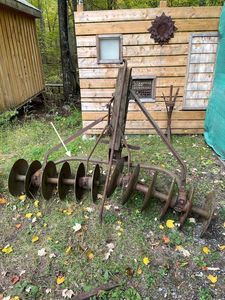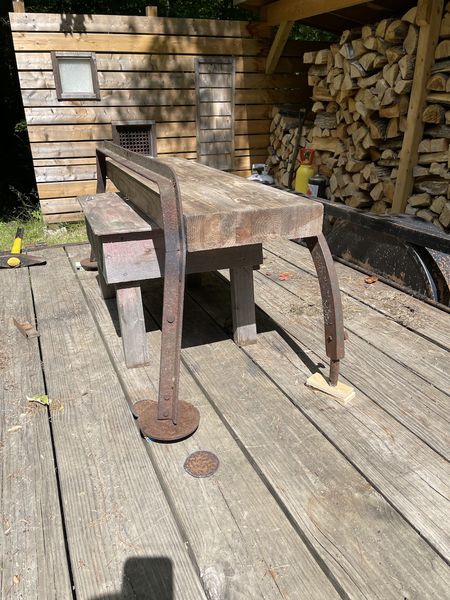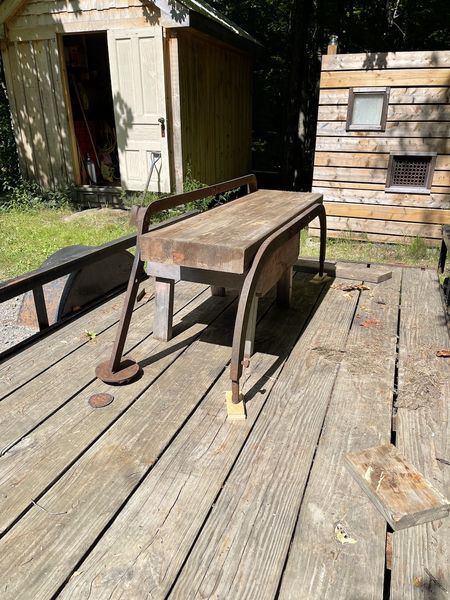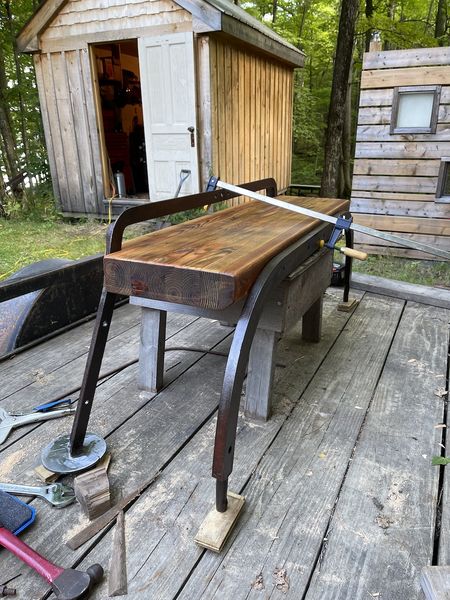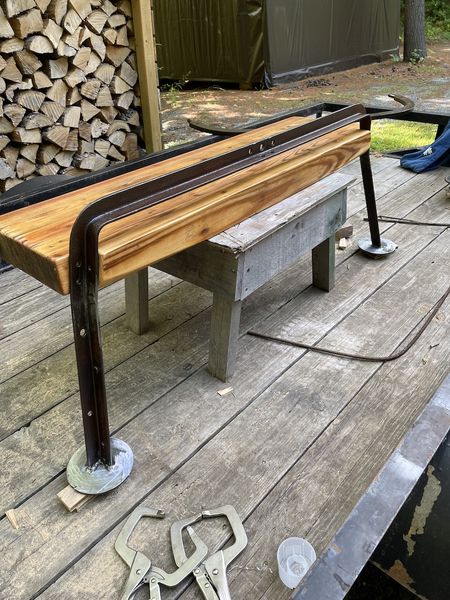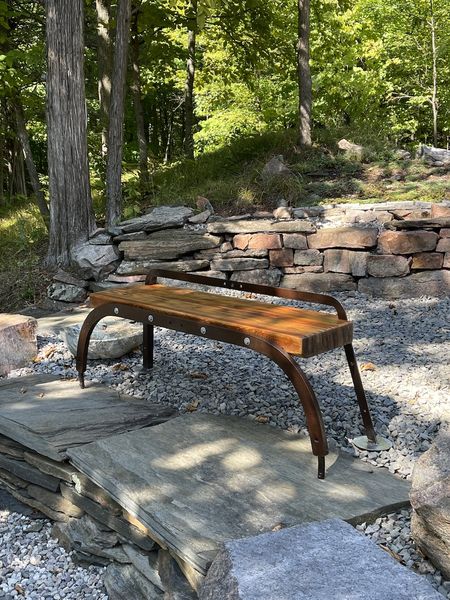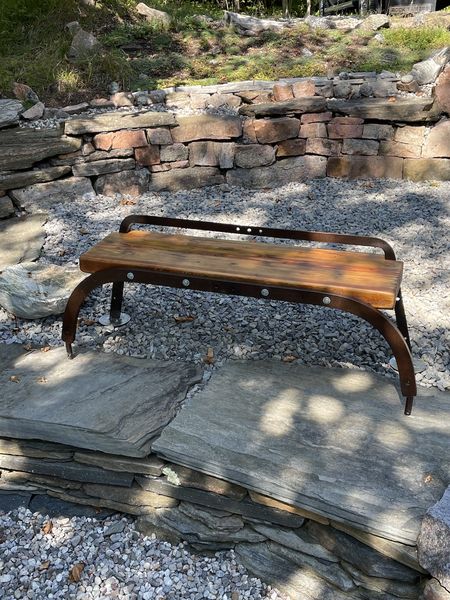Sharon's Bench
By Lorrie Potvin
I met Sharon shortly after I started building my home on Green Lake. In the early times we were more like acquaintances than friends, the kind to say ‘hi’ and exchange a few words than to sit down, have coffee and talk for an hour. We’ve since gotten to coffee time.
It was about 15 years ago when Sharon brought me a section of a laminated beam. It was a leftover piece from the main beam supporting her house, a prow design facing Wolfe Lake. She asked me if I would make her a bench. I didn’t want to disappoint, so I accepted.
My early thoughts were to use a couple of small pieces of a similar beam as legs, inset at an angle to the top, bottoms secured by lengths of steel rod. It didn’t resonate. I tried imagining other versions using different designs and materials. Nothing stuck and I just wasn’t inspired. Besides, I excused myself, I didn’t have the routers or saws to work with such a large chunk of wood, so I put the piece away. For years.
Sharon eventually came knocking. I’d completely forgotten. I remembered seeing it when I was unwrapping layers of tarps I’d used to cover the temporary shelter I was dismantling. It was under a stack of leftover hardwood flooring. She asked for the piece back. Head down, shamed, I told her, “No, I got it. I promise.” Even then I didn’t think it’d take another couple of years to build it.
Why did it take so long? I’ve been blessed with the ability to imagine and visualize in three dimensions, but like with my writing, I needed to see the ending. When writing Two Rivers (unpublished), my first piece of fiction, I had the beginning and a few threads, but it wasn’t until I fully visualized the ending that I could write my way through to it. Much like the bench, I couldn’t start it until I imagined its conclusion.
The vision came to me when I was dismantling a disc harrow. I’d scrounged it from a family farm in South Frontenac near where I live. Harrows aren’t meant to turn a field, instead they are dragged across fields to weed and scuff, prepping and levelling the top layer of soil. It was several days of hard work to separate all the pieces using a sledgehammer, and oxy-acetylene torches to cut off rusted fasteners. As soon as I saw the bar that connected the two rows of harrow discs, I knew I had the design for Sharon’s bench. It was a beautiful piece of rusted steel, heavy, thick, curved beautifully, a perfect piece for the front legs.
The back legs appeared on another harrow I’d picked. A u-shaped piece of angle iron that was used to stabilize and strengthen the front tapered section of the harrow assembly that hooked to the tractor.
I had the front and back legs, and the vision. I was excited, inspired. I set up a small table on my trailer to support the bench top. From there I positioned the legs, using small pieces of plywood as spacers to get the right heights and distances.
To securely fasten the connector bar to the face of the bench I used a drill press to make two more holes in it for a total of four fastening points. After pondering the back legs, I decided to inset them into the back corners of the bench. I also cut out small triangular pieces from the angle iron, where it met the bottom of the back bench. This allowed the legs to taper back, about a 10-degree angle, creating stability but also adding to the aesthetic.
The bottom of the front legs was left alone, leaving the round forged ends in place. Beautifully crafted. The pads for the back legs were cut outs I’d picked up from a rural salvage yard near Yarker. I thought about reconfiguring them into an oval or square, but nothing came so I left them as is.
Your CanLit News
Subscribe to Open Book’s newsletter to get local book events, literary content, writing tips, and more in your inbox
Once I had mocked up the assembly, I took it apart and used a grinder to touch up my welds, and a wire brush to pull out the rusted patina that only decades in the fields can produce. Exquisite. The bench was sanded up to 220 grit before I applied three coats of Tung oil. Once the finish was dry, I set up the assembly again to mark and drill pilot holes for the legs in the bench. I attached the front and back legs with 3/8” galvanized lag bolts, 3” long. A fitting industrial vibe.
Time for delivery! Sharon was out of town, and she didn’t know I had finished her bench. It was to be a compliment for her outdoor oasis, one that included a wood-fired hot tub. With Paula’s help I found the perfect place to set it up as a surprise, which I blew because I could not help but send her pictures.
What are the lessons here? I’ve learned to say maarsii, thank you for the trust and confidence shown in myself by others. I’ve learned I can say no without guilt, without the need to look after others, to not disappoint. And, most importantly, I’ve learned to honour and take care of the creative, to disentangle her from the diminishing voices, including my own, so she can have the space to create the visions which feed her spirit.
Lastly, I’m truly grateful for Sharon’s friendship and patience, for being part of her circle and for her being part of mine on this day and others to come.
All my relations, enjoy,
L. xo
* * *
The views expressed in the Writer-in-Residence blogs are those held by the authors and do not necessarily reflect the views of Open Book.
Tradeswoman, artist, writer, and teacher Lorrie Potvin, a queerishly two-spirited Métis, is the author of Horses in the Sand: A Memoir. Her first book, First Gear: A Motorcycle Memoir and the essays "My tattoos speak of life and loss" and "Why I’m thankful for multiple sclerosis" (The Globe and Mail), were published under her previous surname Jorgensen, as was the short story, "The 13th Dock" in Writing At Wintergreen, an anthology edited by Helen Humphreys.
Working and teaching in the trades for over 30 years, Potvin holds an Inter-Provincial Red Seal in Auto Body Repair and Refinishing from Algonquin College and a diploma in Technological Education from the Faculty of Education, Queen’s University, with additional qualifications in Manufacturing and Special Education. A citizen of the Métis Nation of Ontario, Lorrie lives on a lake north of Kingston in the area served by the High Land Waters Métis Council where she’s lived for 30 years, building her home and creating art made of stone, wood, hide and steel.
